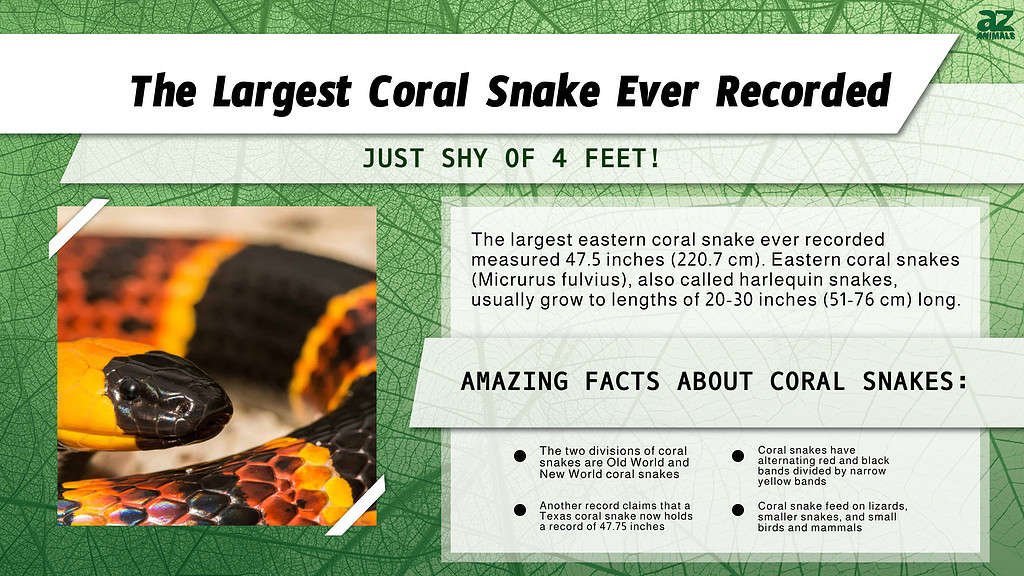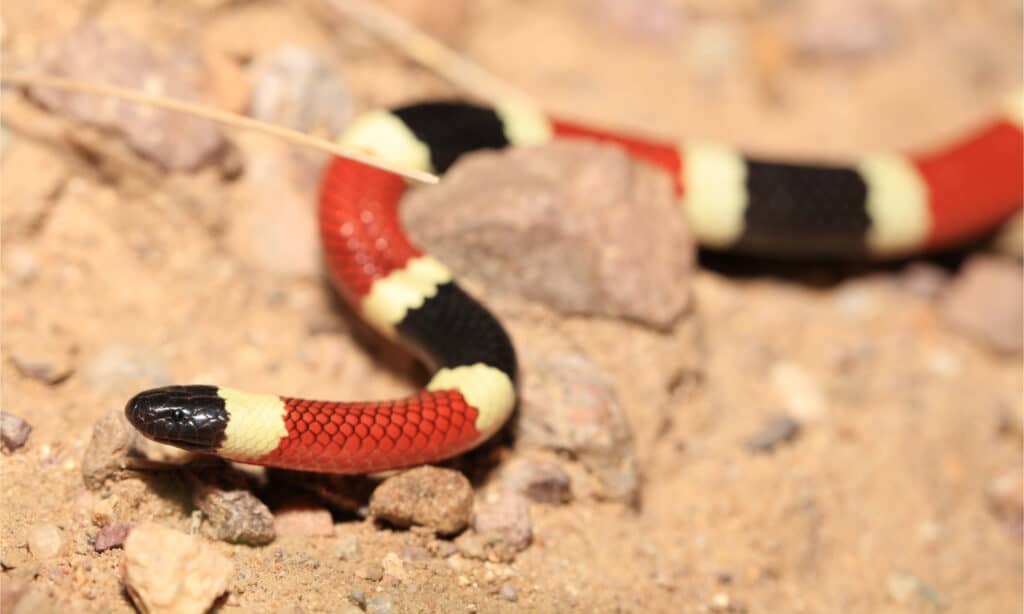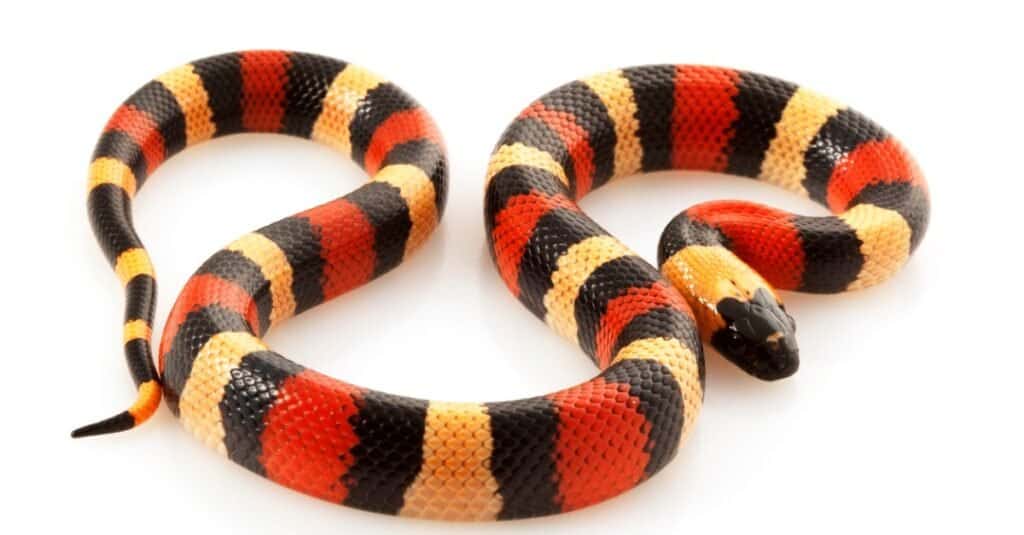The venomous coral snake belongs to the elapid family (Elapidae) with cobras. Old World coral snakes and New World coral snakes are the two main divisions within this genus’s species.
For example, there are 16 species of Old World coral snakes, and there are more than 65 known New World species. There are three genera of New World coral snakes: Leptomicrurus, Micruroides, and Micrurus.

Unlike most snakes, a Harlequin coral snake’s bands of color go completely around their bodies.
©Mark_Kostich/Shutterstock.com
Micrurus has the most New World coral snake species, with 83. They stretch from Florida to Argentina. But just two species live in America. The eastern coral snake, or Micrurus fulvius, dwells in the southeastern U.S. and can be found from North Carolina to Mississippi.
The Texas coral snake, or Micrurus tener, lives in Texas, Louisiana, and Arkansas.
Largest Coral Snake Ever Recorded

Known also as Harlequin snakes, eastern coral snakes are typically around 20-30 inches (51-76 cm) long. The official record for the largest eastern coral snake is 47.5 inches (220.7 cm), which is just shy of 4 feet long!
Another record states that the Texas coral snake now holds a record of 47.75 inches. There are also reports of a 48-inch-long Texas coral snake off the coast of Texas.
Most coral snake species are small, averaging less than three feet in length. However, these two North American kinds have even been rumored to reach a length of five feet, supposedly.
As a result, North American coral snakes (namely eastern and Texas coral snakes) are obviously the largest reported coral snakes on Earth!
Is it Normal for Coral Snakes to Grow Large?

Sonoran coral snakes are very venomous, but they have short fangs that can barely break human skin.
©Alexander Wong/Shutterstock.com
Coral snakes are venomous creatures found in many parts of the world, including North and South America. They are known for their striking and brightly colored bands, which vary in color and pattern depending on the species.
Coral snakes are relatively small and slender, typically measuring around 2-4 feet in length. However, there is some debate among experts about whether it is normal for coral snakes to grow larger than this.
One theory is that coral snakes do not grow much larger than 4 feet in length, as they are relatively small predators that rely on stealth and surprise to catch their prey. However, there have been reports of larger coral snakes measuring up to 6 feet long, although such sightings are relatively rare.
There are also reports of coral snakes growing larger in captivity, although this may be because they are provided with a constant supply of food and do not need to hunt for their meals.
North American Coral Snakes

Eastern coral snakes typically have black coloring until right behind the eyes.
©Jay Ondreicka/Shutterstock.com
Appearance
Known as coral snakes in the United States, North American coral snakes have distinctive red, yellow/white, and black banding.
Red and black bands alternate over the snake’s body, divided by narrow yellow bands. The black spots and flecks in the red rings are common. Black and yellow stripes alternate on the tail. The body’s scales are silky and glossy.
The rounded black nose is followed by a broad yellow stripe behind the eyes on the tiny head, which is not distinct from the neck.
There is a circular pupil, and the little eyes are black, making it difficult to see them clearly. Juveniles have the same coloration as adults. It is possible to tell venomous coral snakes apart from non-venomous snakes by the pattern of stripes on their bodies.
Habitat
North American coral snakes inhabit the southern coastal plains of the United States, ranging from Arizona, Texas, North Carolina, Louisiana, and throughout the state of Florida. They occupy a variety of environments, from dry flatwoods and scrub regions to low, damp areas and edges of swamps. They are secretive and are frequently discovered under garbage and in the ground.
Even though they prefer the cover of trees, they have been observed climbing large trees as well. This species is occasionally found in suburban communities. However, they spend most of their lives buried beneath the ground or hidden, emerging to the surface only when it rains or during mating season.
Diet
Smaller snakes and lizards are the primary food sources for North American coral snakes, as well as nesting birds and small mammals. To get food, these snakes dig through the leaf litter with their heads while creeping slowly. Numerous investigations have suggested that these snakes are mostly nocturnal hunters.
Danger
Venom from North American coral snake species was previously thought to have potent neurotoxins that might paralyze breathing muscles. However, in most documented cases, the bite caused only slight discomfort, although respiratory collapse could follow within hours.
Recently, studies showed that while a bite from a Texas coral snake (Micrurus tener) can be extremely painful, it rarely necessitates the use of antivenin. These clinical characteristics may not apply to all Micrurus species, and more research is needed to confirm this hypothesis.
Bites from venomous snakes like Harlequin coral snakes can be exceedingly deadly to humans and pets, but these bites are relatively rare.
An experienced snakebite specialist or a hospital should be sought out immediately for treatment of the victim’s bite. The Harlequin coral snake is not aggressive and avoids coming into touch with people or pets.
Most snake bites are the result of deliberate contact.
Lifespan: how long do coral snakes live?
Although, little is known about the longevity of coral snakes in the wild. In captivity, coral snakes can live up to about seven years old. With the proper care and diet, coral snakes have been known to live even longer at around 10 years old.
Fun Fact!
Did you know that coral snakes fart? Yep! When threatened or under attack, coral snakes will sometimes forcefully expel air out of their cloaca which makes a loud popping sound to startle the predator.
The “microfarts” are an aggressive-defensive behavior and should not be taken lightly if heard.
Snakes Mistaken for Coral Snakes

Milk snakes have a similar appearance to coral snakes.
©iStock.com/amwu
Many nonvenomous snakes “mimic” North American coral snakes. New World coral snakes are models for numerous nonvenomous snake species that mimic them. Research shows that coral snake color patterns dissuade predators from attacking.
Without coral snakes, animals expected to mimic them are attacked more frequently. For example, four milk snake species and the Texas long-nosed snake have coloration like coral snakes. Scarlet king snakes and scarlet snakes have red, black, and yellow or white banding like coral snakes as well.
Keep in mind: “Red touch yellow, kill a fellow. Red touch black, venom lack!”
To Sum It Up

North American coral snakes are typically non-aggressive if they are left alone.
©iStock.com/JasonOndreicka
Coral snakes are quite effective in eliminating other types of pests and are critical to the functioning of our ecosystems. If you happen to come across one of these snakes while out walking, please leave it alone. Their behavior is non-aggressive, and they will not strike until provoked to do so.
Never pick up a snake that you discover on the ground or attempt to handle it. Most people are bitten in this manner.
Other Record-Breaking Snakes

©iStock.com/Wide-River-Rick
The eastern diamondback rattlesnake is one of the largest venomous snakes found in North America. It is known for its distinctive diamond-shaped markings on its body and its characteristic rattle at the end of its tail, which it uses to warn potential predators.
The largest eastern diamondback rattlesnake ever recorded measured 7.9 feet long and weighed a whopping 34 pounds! This massive specimen was discovered in St. Augustine, Florida, back in 1946. The snake’s size was so impressive that it made headlines across the country.
While this may be the largest recorded individual of this species, these snakes can still grow quite large, with an average length ranging from 3-6 feet long. Eastern Diamondbacks are typically found throughout the southeastern United States and are often seen in wooded areas or near water sources.
Despite their intimidating appearance and deadly venom, eastern diamondback rattlesnakes play an important role in maintaining an ecological balance within their habitats by controlling rodent populations. However, due to habitat loss and overhunting by humans, they have become a threatened species with declining populations.
The photo featured at the top of this post is © iStock.com/JasonOndreicka
Discover the "Monster" Snake 5X Bigger than an Anaconda
Every day A-Z Animals sends out some of the most incredible facts in the world from our free newsletter. Want to discover the 10 most beautiful snakes in the world, a "snake island" where you're never more than 3 feet from danger, or a "monster" snake 5X larger than an anaconda? Then sign up right now and you'll start receiving our daily newsletter absolutely free.
Thank you for reading! Have some feedback for us? Contact the AZ Animals editorial team.






